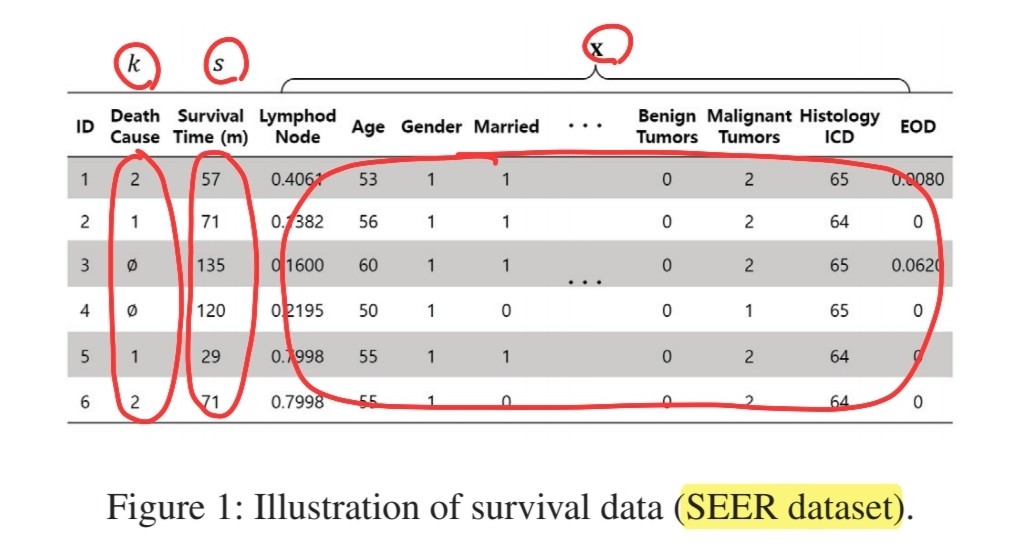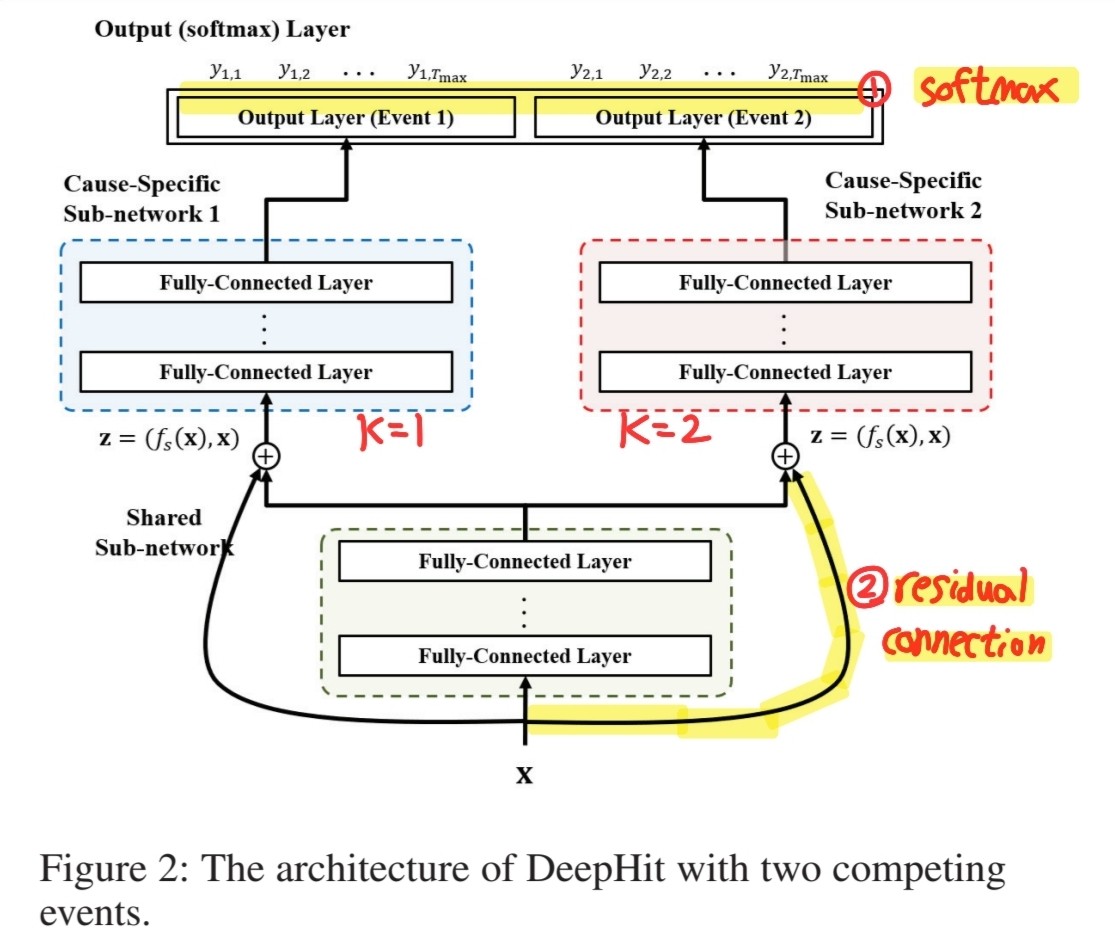DeepHit : A Deep Learning Approach to Survival Analysis with Competing Risks
Contents
-
Abstract
- Introduction
- Survival Analysis
- Survival Data
- Model Description
- Loss Function
0. Abstract
Relationship between “covariates” & “survival times (=times-to-event)”
Previous works :
- assume a specific form for the underlying stochastic process
DeepHit
- 1) makes no assumptions!
- 2) allows for possibility that the relationship between covariates & risks change over time
- 3) handles competing risks
1. Introduction
Survival Analysis is further applied to…
- “discovering risk factors” affecting the survival
- “comparison among risks” of different subjects
DeepHit
- no assumptions about the form of underlying stochastic process
- learns the distribution of first hitting times DIRECTLY
- both cases OK
- 1) single risk ( cause )
- 2) multiple competing risks ( causes )
- architecture
- [1] single shared sub-network
- [2] family of cause-specific sub-networks
- loss function
- [1] survival times
- [2] relative risks
2. Survival Analysis
(1) Survival Data
3 pieces of information
- 1) observed covariates
- 2) time elapsed, since covariates were first collected
- 3) label indicating type of event
Settings :
- time : discrete
- time horizon : finite ( ex. no longer live than 100 years! )
Notation
- time set : \(\mathcal{T}=\left\{0, \ldots, T_{\max }\right\}\)
- possible events : \(\mathcal{K}=\{\varnothing, 1, \cdots, K\}\)
- \(\varnothing\) : “Right-censoring” event
- assumption : “exactly ONE event occurs for each patient”
- triple : \((\mathbf{x}, s, k)\)
- 1) covariate : \(\mathbf{x} \in X\)
- 2) time at which the (unique) event or censoring occurred : \(s\)
- 3) event or censoring that occurred at time \(s\) : \(k \in \mathcal{K}\)
- dataset : \(\mathcal{D}=\left\{\left(\mathbf{x}^{(i)}, s^{(i)}, k^{(i)}\right)\right\}_{i=1}^{N}\)
Goal
-
for each tuple \(\left(\mathbf{x}^{*}, s^{*}, k^{*}\right)\) with \(k^{*} \neq \varnothing\),
-
predict true probability \(P\left(s=s^{*}, k=k^{*} \mid \mathbf{x}=\mathbf{x}^{*}\right)\)
( find estimates \(\hat{P}\) of true probabilities)

(2) Model Description
Goal : learn \(\hat{P}\) ( = estimate of “joint distn of (1) first hitting time & (2) competing events “)
DeepHit : multi-task network
- 1) \(1\) shared sub-network
- 2) \(K\) cause-specific sub-networks
DeepHit vs MTL
- 1) SINGLE softmax layer
- 2) Residual Connection

Cause-specific sub-network
Input : pairs \(\mathbf{z}=\left(f_{s}(\mathbf{x}), \mathbf{x}\right)\)
Output : \(f_{c_{k}}(\mathbf{z})\)
- (= probability of the first hitting time of a specific cause \(k\) )
Totality of these outputs :
- joint probability distn on (1) first hitting time & (2) event
- output of softmax layer :
- \(\mathbf{y}=\left[y_{1,1}, \cdots, y_{1, T_{\max }}, \cdots, y_{K, 1}, \cdots, y_{K, T_{\max }}\right]\).
(cause-specific) Cumulative Incidence Function (CIF)
-
probability that event \(k^{*} \in \mathcal{K}\),
occurs on/before time \(t^{*}\)
conditional on covariates \(\mathbf{x}^{*}\)
-
\(\begin{aligned} F_{k^{*}}\left(t^{*} \mid \mathbf{x}^{*}\right) &=P\left(s \leq t^{*}, k=k^{*} \mid \mathbf{x}=\mathbf{x}^{*}\right) \\ &=\sum_{s^{*}=0}^{t^{*}} P\left(s=s^{*}, k=k^{*} \mid \mathbf{x}=\mathbf{x}^{*}\right) \end{aligned}\).
-
true CIF is not known
\(\rightarrow\) use estimated CIF, \(\hat{F}_{k^{*}}\left(s^{*} \mid \mathbf{x}^{*}\right)=\sum_{m=0}^{s^{*}} y_{k, m}^{*}\)
(3) Loss Function
\(\mathcal{L}_{\text {Total }}=\mathcal{L}_{1}+\mathcal{L}_{2}\).
- \(\mathcal{L_1}\) : log-likelihood of the joint distribution of the first hitting time and event
- \(\mathcal{L_2}\) : combination of cause-specific ranking loss functions.
Term 1 : \(\mathcal{L_1}\)
\(\begin{aligned} \mathcal{L}_{1}=-& \sum_{i=1}^{N}\left[\mathbb{1}\left(k^{(i)} \neq \varnothing\right) \cdot \log \left(y_{k^{(i)}, s^{(i)}}^{(i)}\right)\right. \left.+\mathbb{1}\left(k^{(i)}=\varnothing\right) \cdot \log \left(1-\sum_{k=1}^{K} \hat{F}_{k}\left(s^{(i)} \mid \mathbf{x}^{(i)}\right)\right)\right] \end{aligned}\).
-
total : \(K\) competing risks
-
patients
- (not censored) : captures both the “event” & “time” the event occured
- (censored) : captures “time” censored
Term 2 : \(\mathcal{L_2}\)
\(\mathcal{L}_{2}=\sum_{k=1}^{K} \alpha_{k} \cdot \sum_{i \neq j} A_{k, i, j} \cdot \eta\left(\hat{F}_{k}\left(s^{(i)} \mid \mathbf{x}^{(i)}\right), \hat{F}_{k}\left(s^{(i)} \mid \mathbf{x}^{(j)}\right)\right)\).
\(A_{k, i, j} \triangleq \mathbb{1}\left(k^{(i)}=k, s^{(i)}<s^{(j)}\right)\).
-
estimated CIFs calculated at different times
-
to fine-tune network to each “cause-specific estimated CIF”
-
penalizes incorrect ordering of pairs
-
utilize ranking loss function
-
adapts the idea of concordance
( = patient who dies at \(s\) should have higher risk at time \(s\) , than a patient who survived longer than \(s\) )
-
Notation
- coefficients \(\alpha_{k}\) : chosen to trade off ranking losses of the \(k\)-th competing event
- assume here that the coefficients \(\alpha_{k}\) are all equal (i.e. \(\alpha_{k}=\alpha\) )
- \(\eta(x, y)\) : convex loss function
- use the loss function \(\eta(x, y)=\exp \left(\frac{-(x-y)}{\sigma_{\text {. }}}\right) .\)
